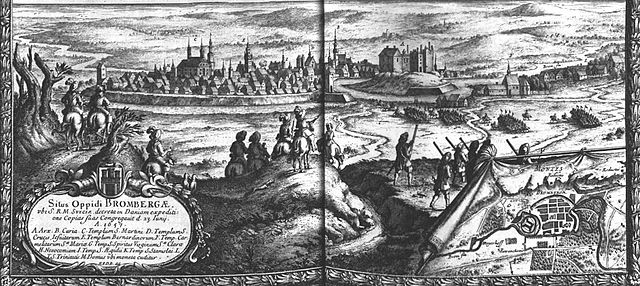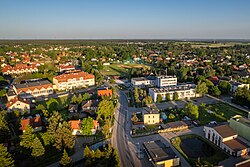Top Qs
Timeline
Chat
Perspective
Bydgoszcz–Toruń metropolitan area
Metropolitan area in Kuyavian-Pomeranian Voivodeship, Poland From Wikipedia, the free encyclopedia
Remove ads
Bydgoszcz–Toruń metropolitan area (Polish: bydgosko-toruński obszar metropolitalny) is the name of the bi-polar metropolitan area in the middle of the Vistula river centered on the cities of Bydgoszcz and Toruń in north-central Poland. The distance between the built-up areas of the cities is about 30 km. They are the administrative capitals and economic centers of Kuyavian-Pomeranian Voivodeship.
Despite the fact that these two cities are integrating gradually, they have been in a great competition through the centuries.[citation needed] In September 2004 the Medical Academy in Bydgoszcz joined Toruń University as Collegium Medicum in Bydgoszcz. Although not without some controversy[to whom?], this is usually considered as an important step in the integration process.[by what?][according to whom?]
Depending on the calculation method and on what is the exact area taken into consideration, the total population varies from between about 600,000 and 800,000 inhabitants.[citation needed]
Remove ads
Population
The total population of the two biggest cities combined (Bydgoszcz[3][4] + Toruń[5]), excluding adjacent communities:
- 1900: 81,839 inhabitants (52,204 + 29,635)
- 1910: 103,923 inhabitants (57,696 + 46,227)[6]
- 1920: 121,354 inhabitants (84,054 + 37,300)
- 1931: 171,808 inhabitants (117,528 + 54,280)[6]
- 1939: 224,275 inhabitants (143,075 + 81,200)
- 1946: 202,699 inhabitants (134,614 + 68,085)[6]
- 1950: 243,161 inhabitants (162,524 + 80,637)[6]
- 1955: 294,594 inhabitants (202,044 + 92,550)
- 1960: 336,913 inhabitants (232,007 + 104,906)[6]
- 1995: 590,716 inhabitants (386,056 + 204,660)
- 2020: 545,197 inhabitants (344,091 + 201,106)
Remove ads
History


Historically, Bydgoszcz and Toruń were the most important royal cities in the area. Both cities hosted sessions of the Polish Parliament, i.e. Bydgoszcz in 1520, and Toruń in 1576 and 1626.[7] It is also where Peaces of Thorn and Treaty of Bromberg were signed. The two were parts of different administrative units for centuries, with Bydgoszcz starting as Polish and Toruń as Teutonic settlements, then becoming the biggest cities of Inowrocław Voivodeship and Chełmno Voivodeship in the Polish-Lithuanian Commonwealth, later in Germany of Bromberg district (Province of Posen) and Marienwerder district (West Prussia).
This would change only in the year of 1938, when Bydgoszcz was moved from the Poznań to the Pomeranian Voivodeship with Toruń, soon to take the role of the capital of the whole region.[8]
The postwar growth of the cities and the new political administrative landscape led to application of the term "Bydgoszcz-Toruń metropolitan area" which first appeared in the 1960s.[9]
Remove ads
Education
- Nicolaus Copernicus University in Toruń
- Casimir the Great University in Bydgoszcz
- Bydgoszcz University of Science and Technology
- Collegium Medicum in Bydgoszcz of the Nicolaus Copernicus University
- Feliks Nowowiejski Music Academy, Bydgoszcz
- Jagiellonian College, Toruń
Sights
Summarize
Perspective

The main sights of the agglomeration are the old towns of Bydgoszcz and Toruń, with the latter listed as a World Heritage Site. The local spa town is Ciechocinek, and its graduation towers, saline and spa parks are declared a Historic Monument of Poland.[10]
The metropolitan area is rich in historic architecture ranging from Romanesque and Gothic architecture to Renaissance, Baroque and Art Nouveau. There are also several castles and palaces, including Dybów, Zamek Bierzgłowski, Ostromecko, Żołędowo. The Dybów Castle was the place where in 1454 King Casimir IV Jagiellon issued the famous Statutes of Nieszawa, covering a set of privileges for the Polish nobility; an event that is regarded as the birth of the noble democracy in Poland, which lasted until the late-18th-century Partitions of Poland.
Bydgoszcz and Toruń host major museums and art galleries, including the Leon Wyczółkowski Regional Museum in Bydgoszcz and District Museum in Toruń. The more unique museums include:
- Copernicus House in Toruń, museum dedicated to Nicolaus Copernicus
- European Museum of Money at the former Polish Royal Mint in Bydgoszcz
- Museum of Toruń Gingerbread in Toruń
- Museum of Far Eastern Art in the Under the Star Tenement House in Toruń
- Andrzej Szwalbe Collection of Historical Pianos at the palace in Ostromecko, one of two largest such collections in Poland
- Exploseum in Bydgoszcz, operated at the site of a former Nazi German arms factory.
Remove ads
Sports
Summarize
Perspective
Motorcycle speedway, basketball and volleyball enjoy the largest following in the metropolitan area. The KS Toruń and Polonia Bydgoszcz clubs are among the most accomplished speedway clubs in the country and contest the Pomeranian-Kuyavian Derby, one of the fiercest speedway rivalries.

Remove ads
See also
References
Wikiwand - on
Seamless Wikipedia browsing. On steroids.
Remove ads








